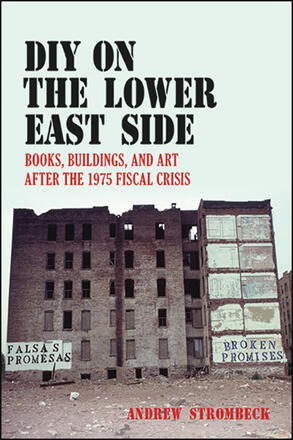
DIY on the Lower East Side
Books, Buildings, and Art after the 1975 Fiscal Crisis
Alternative formats available from:
Engaging look at Lower East Side writers and artists in the wake of the 1975 New York fiscal crisis.
Description
The severe financial austerity imposed on New York City during the 1975 fiscal crisis resulted in a city falling apart. Broken windows, crumbling walls, and piles of bricks were everywhere. While, for many, this physical decay was a sign that the postwar welfare state had failed, for others, it represented a site of risky opportunity that could stimulate novel forms of creativity and community. In this book, Andrew Strombeck explores the legacy of this crisis for the city's literature and art, focusing on one neighborhood where changes were acutely felt—the Lower East Side.
In what became a paradigmatic example of gentrification, the Lower East Side's population shifted from working-class people to Wall Street traders and ad agents. This transformation occurred, in part, because of high-profile local artists such as Jean-Michel Basquiat, Keith Haring, Jeff Koons, and Kiki Smith, but Strombeck argues that neighborhood writers also played a role. Drawing on archival research and original author interviews, he examines the innovative work of Kathy Acker, David Wojnarowicz, Miguel Piñero, Sylvère Lotringer, Lynne Tillman, and others and concludes that these writers still have much to teach us about changes in the nature of work and the emergence of a do-it-yourself ethos. DIY on the Lower East Side shows how place and politics shaped literature, and how New York City policies adopted at the time continue to shape our world.
Andrew Strombeck is Professor of English at Wright State University.
Reviews
"Strombeck taps into a current interest in economic crises as foundations for literary and artistic expression. He discusses conditions of economic precarity as seedbeds for artistic innovation and for innovative ways of organizing daily life and being in the world." — Sarah Brouillette, author of Literature and the Creative Economy
"The author traces the complex and agonistic filigree of artistic engagements with gentrification, precisely because these artists are often knowingly contributing to it. He shows there were more social and aesthetic possibilities available within the historical moment of the 1970s and '80s than have been generally acknowledged, and the gentrification of the possibilities is all the more devastating given that the writers and artists documented here were deeply invested in preserving and engaging with extant underclass communities and cultures in the city. This is an important and beautifully written work of literary history." — Tyler Bradway, author of Queer Experimental Literature: The Affective Politics of Bad Reading